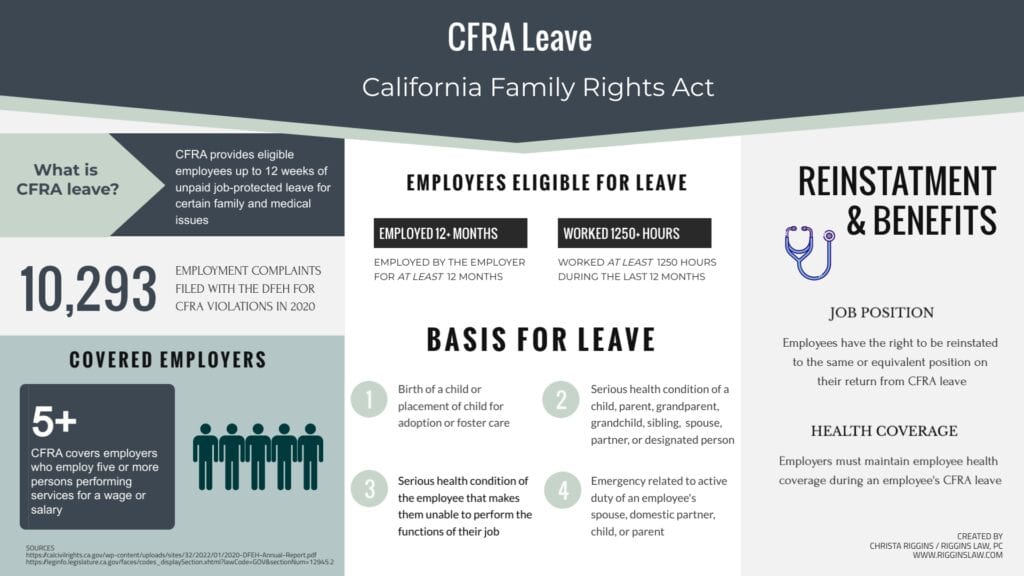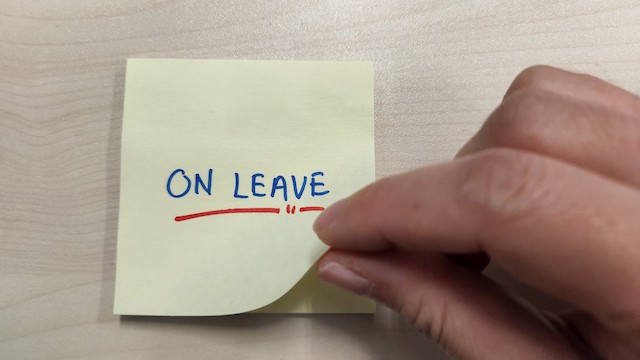CFRA, short for the California Family Rights Act, is a California statute that provides eligible employees up to 12 weeks of unpaid, job-protected leave for certain family and medical issues. This blog attempts to answer the most common questions asked by employees who are either on CFRA leave or trying to determine whether they qualify for leave.
Employers Covered By CFRA – 5+ Workers
The CFRA defines an employer as “any person or individual engaged in any business or enterprise regularly employing five or more individuals.” (2 Cal. Code Regs., § 11008, subd. (d).) This means the employer must employ five or more individuals on any part of the day the unlawful conduct occurred or five or more employees on a “regular basis.” (2 Cal. Code Regs., § 11008, subd. (d)(1).) The “regular basis” option of counting workers addresses businesses that operate periodically. For instance, the CFRA would cover a Halloween store that is only open from August through November (4 months) so long as at least five employees are regularly on the payroll during the four months of operation.
Notably, part-time employees are counted the same as full-time employees, and employees on paid or unpaid leave are also counted despite their absence from work. (2 Cal. Code Regs., § 11008, subd. (d)(1)(B).) Furthermore, the use of the term individuals (as opposed to employees) indicates that independent contractors are included for counting purposes. (2 Cal. Code Regs., § 11008, subd. (d)(1).) There is also caselaw suggesting that owners who perform services for the business count as employees.
If you work for a large company, they likely easily meet the five-worker threshold. However, smaller employers sometimes require more careful analysis. In those cases, an attorney may consider whether an employer has misclassified employees as independent contractors. For instance, if the “independent contractors” perform work in the usual course of the hiring entity’s business, they may be misclassified (e.g., a bakery that hires a cake decorator to work on its custom design cakes is not an independent contractor). An attorney may also consider whether there is a joint employment relationship where two interrelated businesses can be treated as one for purposes of CFRA coverage.
CFRA Leave Eligibility – 12 months service & 1250 hours worked
To be eligible for a CFRA leave, a California employee must meet the following criteria:
- employed by the employer for at least 12 months as of the date leave commences, and
- employed for at least 1250 hours of service during the 12 months immediately preceding the commencement of the leave.
For purposes of calculating the 12 months of employment (the first criterion), an employee on the payroll for any part of a week is deemed to have worked the entire week. In addition, the 1,250 hours of service requirement breaks down to approximately 24 hours per week. This number is for reference only, meaning it is provided to give part-time employees an idea of whether they may qualify for leave, given their weekly work schedule. However, the law merely requires that you worked at least 1,250 hours in the previous 12-month period. There is no weekly or monthly hourly requirement.
Basis for CFRA Leave – Certain Family and Medical Issues
If an employee meets the eligibility criteria and CFRA covers their employer, the employee is entitled to up to 12 weeks’ leave for any of the following reasons:
- The birth of a child of the employee or the placement of a child with an employee in connection with the adoption or foster care of the child.
- To care for a child, parent, grandparent, grandchild, sibling, spouse, domestic partner, or designated person with a serious health condition.
- For an employee’s serious health condition that makes the employee unable to perform the functions of their job, except for leave taken for disability on account of pregnancy, childbirth, or related medical condition. (Note: Pregnancy, childbirth, and related medical conditions are covered under California’s Pregnancy Disability Leave Law (“PDLL”).)
- For a qualifying exigency related to the covered active duty or call to covered active duty of an employee’s spouse, domestic partner, child, or parent in the Armed Forces of the United States
Under CFRA, a “serious health condition” means “an illness, injury, impairment, or a physical or mental condition…that involves either inpatient care or continuing treatment, including, but not limited to, treatment for substance abuse.” (2 Cal. Code Regs., § 110087, subd. (u).)
For an employee to be entitled to leave under the CFRA for their own serious health condition, the condition must cause them to be unable to work at all or perform one or more of the essential functions of their position, regardless of whether they could perform a similar or different job. (Lonicki v. Sutter (2008) 43 Cal.4th 201, 216 [plaintiff suffered from work-related stress that prevented her from performing her full-time job, and her part-time job at a different hospital did not conclusively establish she was able to perform similar duties full time at defendant’s hospital].)
Leave Duration – 12 weeks
As mentioned, eligible employees of covered employers have the right to take 12 weeks of leave in a 12-month period. For full-time employees working eight-hour days, this means 60 days off. Part-time employees have their leave entitlement adjusted based on the proportion of hours they work. To illustrate this, here are a few examples:
- An employee works 5 four-hour days per week (20 hours per week). The 12 workweeks can be 30 eight-hour days or 60 four-hour days.
- An employee works 4 six-hour days per week (24 hours per week). The 12 workweeks can be 36 eight-hour days or 48 six-hour days.
The same calculation applies to an employee that works more than forty hours per week. For instance, an employee who works 6 eight-hour days per week (48 hours per week) would be entitled to 72 eight-hour days of CFRA leave. The CFRA permits employees to take this leave on an intermittent or reduced schedule basis.
Right to CFRA Leave, Reinstatement, and Continued Health Benefits
If an employee meets the requirements for leave, an employer must grant the medical leave of absence. Furthermore, an employer must reinstate an employee returning from CFRA leave to the same position they held before their leave or to an equivalent position if the employee’s position no longer exists. An equivalent position means the same pay, benefits, and other terms of employment. The employer must also maintain the employee’s health insurance coverage during their leave.
Conclusion
For more information on medical leaves of absence, please look at my practice areas page on Medical Leaves and my previous posts titled Working While on FMLA Leave: What Employers Can and Cannot Ask of You and Maximum Leave Policies that Violate the ADA and FEHA.
Click here or the image at the beginning of this blog to download the CFRA Leave Info Sheet.




